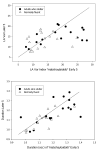Increasing phonological complexity reveals heightened instability in inter-articulatory coordination in adults who stutter
- PMID: 20412979
- PMCID: PMC2859203
- DOI: 10.1016/j.jfludis.2009.12.001
Increasing phonological complexity reveals heightened instability in inter-articulatory coordination in adults who stutter
Abstract
The potential role of phonological complexity in destabilizing the speech motor systems of adults who stutter was explored by assessing the performance of 17 adults who stutter and 17 matched control participants on a nonword repetition task. The nonwords varied in length and phonological complexity. Behavioral results revealed no differences between the stuttering and normally fluent groups on accuracy of nonword repetition. In contrast, dramatic differences between groups were observed in the kinematic data. Indices of the consistency of inter-articulator coordination revealed that adults who stutter were much less consistent in their coordinative patterns over repeated productions. With increasing length and complexity of the nonwords, between-group differences in coordinative consistency were more pronounced. Coordination consistency measures revealed that adults who stutter (but not normally fluent adults) showed within-session practice effects; their coordinative consistency improved in five later compared to five earlier productions. Adults who stutter produced the nonwords at a slower rate, but both groups showed increased rates of production on the later trials, indicating a practice effect for duration for both groups. We conclude that, though the adults who stutter performed behaviorally with the same accuracy as normally fluent adults, the nonword repetition task reveals remarkable differences in the speech motor dynamics underlying fluent speech production in adults who stutter compared to their normally fluent peers. These results support a multifactorial, dynamic model of stuttering in which linguistic complexity and utterance length are factors that contribute to the probability of breakdown of the speech motor system.
Educational objectives: After reading this article, the reader will be able to: (1) summarize the literature on potential language/motor interactions in stuttering, and (2) evaluate to what extent the study findings support the hypothesis that phonologically complex utterances have a destabilizing effect on the speech motor system in individuals who stutter.
Figures




References
-
- Arndt J, Healey EC. Concomitant disorders in school-aged children who stutter. Language, Speech, and Hearing Services in Schools. 2001;32:68–78. - PubMed
-
- Bosshardt HG. Subvocalization and reading rate differences between stuttering and nonstuttering children and adults. Journal of Speech and Hearing Research. 1990;33:776–785. - PubMed
-
- DeNil LF. The influence of phonetic context on temporal sequencing of upper lip, lower lip, and jaw peak velocity and movement onset during bilabial consonants in stuttering and nonstuttering adults. Journal of Fluency Disorders. 1995;20:127–144.
-
- Dollaghan CA, Campbell TF. Nonword repetition and child language impairment. Journal of Speech, Language, and Hearing Research. 1998;41:1136–1146. - PubMed
Publication types
MeSH terms
Grants and funding
LinkOut - more resources
Full Text Sources
Medical

